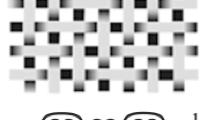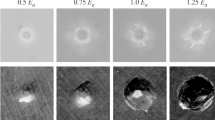Abstract
The fracture surface micromorphology of noon 66 and its blends was examined. A patchy appearance, found at low ΔK values when levels of imbibed moisture and impact modifier are low, is believed to result from a void coalescence mechanism. At higher water contents and levels of impact-modification, the fracture surface assumes a rumpled appearance with numerous secondary fissures oriented normal to the crack direction; the inter-rumple spacings, however, do not correspond to the macroscopic growth rate, A model to explain rumple formation is presented. The fatigue fracture surface appearance of unmodified nylon 66 is found to depend on both moisture content and test temperature. Trans-spherulitic fracture is found when the test temperature is below the glass transition temperatureT g (measured at 110 Hz) for a given water content, while at higher test temperatures a high degree of drawing is evident. It is concluded that the fracture surface micromorphology of nylon 66 and its blends depend strongly on the viscoelastic state of the polymer.
Similar content being viewed by others
References
R. W. Hertzberg andJ. A. Manson, “Fatigue of Engineering Plastics” (Academic, New York, 1980).
R. W. Hertzberg, M. D. Skibo andJ. A. Manson, ASTM STP 675, (American Society for Testing and Materials, Philadelphia), 1979) p. 471.
P. E. Bretz, PhD thesis Lehigh University (1980).
P. E. Bretz, R. W. Hertzberg andJ. A. Manson,J. Mater. Sci. 16 (1981) 2070.
J. R. White andJ. Teh,Polymer 20 (1979) 764.
P. E. Bretz, R. W. Hertzberg andJ. A. Manson,ibid. 22 (1981) 1272.
Idem, J. Appl. Polym. Sci. 27 (1982) 1707.
K. Friedrich,Fracture 3 (1977) 1119.
R. W. Hertzberg, M. D. Skibo andJ. A. Manson, ASTM STP 700 (American Society for Testing and Materials, Philadelphia, 1980) p. 49.
M. T. Hahn, R. W. Hertzberg andJ. A. Manson,J. Mater. Sci. 18 (1983) 3551.
M. T. Hahn, R. W. Hertzberg, J. A. Manson andL. H. Sperling,Polymer, in press.
M. T. Hahn, R. W. Hertzberg andJ. A. Manson,J. Mater. Sci. 21 (1986) 31.
L. Engel, H. Klingele, G. W. Ehrenstein andH. Scraper, “An Atlas of Polymer Damage” translated by M. S. Welling (Prentice-Hall, Engelwood cliffs, New Jersey, 1981).
E. A. Flexman, jr, Proceedings of the International Conference on Toughening of Plastics, London, July 1978 (Rubber and Plastics Institute, London) p. 14.1.
R. N. Haward andI. Brough,Polymer 10 (1969) 724.
J. W. S. Hearle andI. E. Clarke, “Fatigue `81” edited by F. Sheratt and J. B. Sturgeon (Westbury House, Guilford, Surrey, England, 1981) p. 210.
M. I. Koran, “Nylon Plastics” (Wiley-Interscience, New York, 1973) p. 318.
Author information
Authors and Affiliations
Rights and permissions
About this article
Cite this article
Hahn, M.T., Hertzberg, R.W. & Manson, J.A. Effects of rubbery phase and absorbed water on impact-modified nylon 66. J Mater Sci 21, 39–45 (1986). https://doi.org/10.1007/BF01144696
Received:
Accepted:
Issue Date:
DOI: https://doi.org/10.1007/BF01144696




